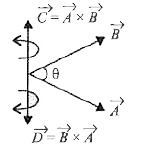Given →C=→A×→Band →D=→B×→A What is the angle between →C and →D ?
30∘
60∘
90∘
180∘
The correct Answer is:D

From figure angle between →C and →D is 180∘
Topper's Solved these Questions
- KINEMATICS BOOK - MTG-WBJEECHAPTER - KINEMATICS EXERCISE - WB JEE WORKOUT ( CATEGORY 3 : One or More than One Option Correct Type (2 Marks))
10 Videos
- KINEMATICS BOOK - MTG-WBJEECHAPTER - KINEMATICS EXERCISE - WB JEE Previous Years Questions (CATEGORY 1 : Single Option Correct Type (1 Mark) )
9 Videos
- KINEMATICS BOOK - MTG-WBJEECHAPTER - KINEMATICS EXERCISE - WB JEE Previous Years Questions (CATEGORY 3 : One or More than One Option Correct Type (2 Marks) )
1 Videos
- HEAT AND THERMAL PHYSICSBOOK - MTG-WBJEECHAPTER - HEAT AND THERMAL PHYSICSEXERCISE - WB JEE PREVIOUS YEARS QUESTIONS
15 Videos
- KINETIC THEORY OF GASES BOOK - MTG-WBJEECHAPTER - KINETIC THEORY OF GASES EXERCISE - WB JEE PREVIOUS YEARS QUESTIONS (MCQ)
7 Videos
Similar Questions
Knowledge Check
Given →C=→A×→Band→D=→B×→A. What is the angle between →C and →D ?
A30∘B60∘C90∘D180∘If →a,→b,→c,→d are unit vectors such that →a.→b=12, →c.→d=12 and angle between →a×→b and →c×→d is π6 then the value of ∣∣[→a→b→d]→c−[→a→b→c]→d∣∣=
A3/2B3/4C3/8D2
Vectors →Cand→D have magnitudes of 3 units and 4 units, respectively. What is the angle between the directions of →Cand→D if →C.→D equals (a) zero, (b) 12 units , and (c ) -12 units ?
View SolutionVectors →Cand→D have magnitudes of 3 units and 4 units, respectively. What is the angle between the directions of →Cand→D if →C.→D equals (a) zero, (b) 12 units , and (c ) -12 units ?
View SolutionIf →a,→b,→c,→d are unit vectors such that →a.→b=12, →c.→d=12 and angle between →a×→b and →c×→d is π6 then the value of ∣∣[→a →b →d]→c−[→a →b →c]→d∣∣=
View SolutionIf →a×→b=→c×→d and →a×→c=→b×→d, show that (→a−→d) is parallel to (→b−→c).
View SolutionIf →a×→b=→c×→dand→a×→c=→b×→d show that (→a−→d) is parallel to (→b−→c). It is given that →a≠→d and →b≠→c.
View SolutionIf →a×→b=→c×→dand→a×→c=→b×→d show that (→a−→d) is parallel to (→b−→c).
View Solution
